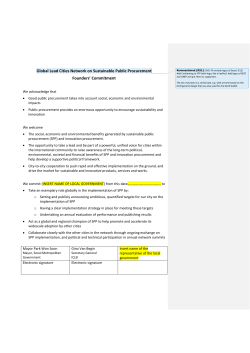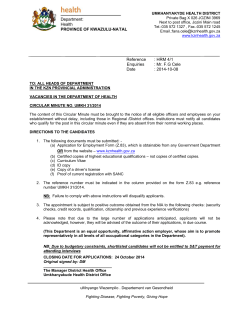
Other risk factors to develop severe nosocomial infections
Complex and severe infection management of immunocompromized patients – focus on oncooncohematology Diseases associated with severe immunocompromise Congenital immunodeficiency syndromes Cancer Chemo-, radiotherapy Stem cell and organ trancplantation HIV infection/AIDS Severe autoimmune diseases Long-lasting corticosteroid treatrment Prof. Csongor Kiss Other risk factors to develop severe nosocomial infections Multiple, overlapping risk factors of infections render cancer patients particularly vulnerable Diabetes mellitus Childhood cancer is a rare disease BUT it represents a significant public health problem! (Morbidity, mortality, QoL QoL,, social segregation of pts and their families, costs – for the involved families and for the society) Chronic liver/renal diseases Alcohol/drug dependence Excessive surgery/trauma Long-lasting treatmant in ICU (mechanical ventillation, i.v. lines) Malnutrition Low/high age Splenectomy Cancer and its treatment impairs barrier function of the skin and mucosal surfaces Natural and adaptive immunity Defence Barriers Leukemic infiltration and bleeding of the gingiva UreteroUreterocutaneo-cutaneo stoma Natural Mechanical integrity Secretion Mucociliar function Phagocytes Humoral factors Lysosim Lactoferrin Interferons Interleukins Cellular factors Phagocytes NK cells Adaptive Immunoglobulins Immunoglobulins T lymphocytes Severe oral mucositis due to cytostatic chemotherapy 1 The most important host factor of both local and systemic antimicrobial defence in cancer patients is: is: neutrophil polymorpho polymorphonuclear nuclear leukocytes The most frequent and significant manifestation of infection in the neutropenic cancer patient is FEVER NeutroNeutropenia Cancer Chemo Chemo-therapy INFECTION NeutroNeutropenia FEVER Impaired barrier function Febrile Neutropenia (FN) What is febrile neutropenia? What to do with a patient with febrile neutropenia? Evaluation (patient and microbe) – risk assessment Treatment Who should receive empirical Rx? When should empirical Rx be started? What is appropriate initial Rx? How should initial Rx be modified? How long should empirical Rx be continued? Significance of FN in pediatric oncology commonest cause of unplanned hospital admissions for pediatric patients on therapy for cancer mortality t lit rate t ≅ 1% (90% iin 1962 1962, 27% iin 1978 and 7% in 1994) significant morbidity significant cost NeutroNeutropenia FN – what is it? Many definitions of both fever and neutropenia EG. Infectious Diseases Society of America Guidelines fever : single oral temperature ≥ 38.3°C temperature ≥ 38.0°C for at least an hour axillary ill t temp 38 0 38 5oC 2x/24 38.0-38,5 2 /24 h or ≥ 38.5 38 5oC 1x 1 neutropenia: ANC /(J+Band+Se) x WBC/ < 0.5 x 109/L or < 1.0 x 109/L with a predicted decrease to < 0.5 x 109/L severe neutropenia: ANC < 0.2 x 109/L neutropenic patients who are unwell but afebrile, and non- neutropenic febrile patients expected neutropenic, => treat as per FN Pt to become Neutropenia: single most important risk factor for infection in cancer patients Most frequently - bacterial infection Risk of infection increases 10- fold with declining neutrophil counts < 500/mm3 48-60% : occult infection 16-20% with neutropenia<100/mm3 have bacteremia 2 Possible sites of infection Evaluation Should be thorough but quick! Should include: History (type and stage of cancer and its treatment, previous infections, etc.) Physical examination: respect minimal signs! Risk assessment Investigations (lab, culture, imaging) Preantibiotic Investigations Blood C/S : central line & peripheral Chest X-Ray Urine C/S URTI Dental sepsis Mouth ulcers Skin sores Exit site of central venous catheters Anal fissures GI Febrile Neutropenia Bacterial causes (EORTC) (60-70%) Gram-negative bacilli (30-40%) Gram-positive bacteria Stool C/S Biopsy cultures Viral studies Gram--positive Bacteria Gram Gram--negative Bacteria Gram Staphylococcus spp : Escherichia coli MSSA,MRSA, Streptococcus spp : viridans Enterococcus faecalis/faecium Corynebacterium spp Bacillus spp Stomatococcus mucilaginosus Klebsiella spp : ESBL Pseudomonas aeruginosa Enterobacter spp Acinetobacter spp Citrobacter spp Stenotrophomonas maltophilia 3 Anerobic Bacteria Bacteroides spp Clostridium spp Fusobacterium spp Propionibacterium spp Peptococcus spp Veillonella spp Peptostreptococcus spp Low Risk Patients in remission receiving conventional chemother., i.e. patients w/o AML or ALL/NHL in induction expected duration of neutropenia ≤ 7 days clinically clinicall and hemodynamically hemod namicall stable unexplained or simple infection no other significant comorbidities no system involvement absolute monocyte count > 150/mm3 C-reactive protein < 90mg/L select good candidates for outpatient therapy High Risk Patients Need parenteral antibiotics + close monitoring Hematological malignancies Severe and prolonged neutropenia Evidence of cardiovascular instability, shock / dehydration d h d ti Mucositis preventing oral hydration Complex focal infection eg CVL site infection Respiratory / gastrointestinal involvement Need for blood products Renal / hepatic insufficiency Change in mental status Immediate Introduction of Initial Empiric Antibiotics - Rationale tumors Initial Empiric Antibiotics Considerations Severe risk of bacterial sepsis Insensitivity of diagnostic tests Delays in identification of pathogens Initial Empiric Antibiotics Recommended choices Broad spectrum of bactericidal activity Local prevalence, susceptibility pattern Monotherapy Antibiotic toxicity : well-tolerated, allergy Duotherapy without vancomycin Host factors : severity of presentation Vancomycin V i plus l one or ttwo d drugs Prior antibiotic usage Antibiotic costs Ease of administration 4 Combination Therapy Advantages Combination Therapy Disadvantages Increased bactericidal activity Drug toxicities Potential synergistic effects Drug interactions Broader antibacterial spectrum p Potential cost increase Limits emergence of resistance Administration time Start Empiric Ab Therapy – e.g. According to Infectious Diseases Society of America Guidelines monotherapy with ceftazidime, cefepime, imipenem or meropenem, Or aminoglycoside + antipseudomonal penicillin, cephalosporin or carbapenem Initial Vancomycin + added antibiotics only if; suspected catheter related infection potential for severe mucositis known colonization with penicillin and cephalosporin-resistant pneumococci or MRSA gram positive organisms awaiting sensitivity cardiovascular compromise guidelines continued … Initial Outpatient FN therapy – Low--risk Patients only! Low Increasingly, published trials are supporting the efficacy of outpatient therapy Less cost Preferred by most families Reduced nosocomial infection risk Reduced administration of broad-spectrum antibiotics and associated drug resistance Reduced treatment-related toxicity If used as initial therapy, Vancomycin should be given with ceftazidime or cefepime, +/- an aminoglycoside, or with carbapenem +// an aminoglycoside, or with an anti-pseudomonal penicillin and an aminoglycoside (Cave: BREAKTHROUGH infections!) Add antifungal at day 5 Out--patient Antibiotics – Conditions Out Allowing Administration Adequate institutional and community infrastructure Trained health professionals 1) at discharge from hospital and 2) at regular review in the home / hospital setting Detect early deterioration / lack of response to minimize morbidity and mortality Family selection; compliance, transportation, geography 24hr advice and emergency care Antimicrobials chosen on patient condition, ease of administration and local sensitivities 5 Initial Antibiotic Modifications Considerations Persistent Fever Causes Nonbacterial infection Persistence of fever Resistant bacteria Clinical deterioration Slow response to antibiotics Culture results Fungal sepsis Drug intolerance/side effects Inadequate serum & tissue levels Drug fever Persistent Fever > Choices of Mx 5 Days Duration of Antibiotic Therapy When to stop? Continue initial Rx No infection identified after Change or add antibiotics ANC 3 days of Rx > 500 for 2 consecutive days Afebrile > 48 hr Add an antifungal drug(Ampho B) Clinically well Algorithm for initial management of febrile neutropenia Fever (temperature ≥38.8ºC) + neutropenia (<500 neutrophils/mm3) Low risk Oral Vancomycin not needed Monotherapy Ciprofloxacin + Amoxicillin / clavulanate (adults only) Fever (temperature ≥38.8ºC) + neutropenia (<500 neutrophils/mm3) Hypotension or other evidence of cardiovascular impairment Potential severe Low mucositis risk High risk High risk IV • Cefepime, • Ceftazidime or • Carbapenem Two drugs • • • • Aminoglycoside + Antipseudomonal penicillin, Cefepime, Ceftazidime, or Carbapenem Clinically suspected catheter infection Algorithm initial management of febrile Colonization byfor penicillin/cephalosporin-resistant pneumococci or MRSA neutropenia Bacteremia by GPC Vancomycin needed Oral IV Vancomycin + Vancomycin + • Cefepime, • Ceftazidime or • Carbapenem ± Aminoglycoside Reassess after 3–5 days Reproduced with permission from Hughes et al. Clin Infect Dis 2002;34:730–751 Vancomycin not needed Monotherapy Ciprofloxacin + Amoxicillin / clavulanate (adults only) • Cefepime, • Ceftazidime or • Carbapenem Two drugs • • • • Aminoglycoside + Antipseudomonal penicillin, Cefepime, Ceftazidime, or Carbapenem Vancomycin needed Vancomycin + Vancomycin + • Cefepime, • Ceftazidime or • Carbapenem ± Aminoglycoside Reassess after 3–5 days Reproduced with permission from Hughes et al. Clin Infect Dis 2002;34:730–751 6 Febrile Neutropenia Conclusions Significant morbidity & mortality Choice of initial empiric therapy dependent on epidemiologic & clinical factors Monotherapy as efficacious as combination Rx Modifications upon reassessment Duration dependent on ANC 7
© Copyright 2025









